
The Dictator’s Dilemma: Hong Kong Case Study
Author: Tim Clancy
Portions of this article are taken from commentaries made over the course of the last six months as events happened. These sections are cited where appropriate but may not appear in chronological order of their posting. All sources are posted in order of appearance at the end of the article.
The continuing instability and protests in Hong Kong provide a useful case study for understanding the Dictator’s Dilemma. The Dictator’s Dilemma is a frequent pattern of behavior in asymmetric conflict that consists of a popular movement demanding civil reform, the “People”, and an authoritarian regime or despot, the “Dictator.” Understanding this pattern of behavior can help maneuver a state-actor into the Dilemma. This initiates a cycle of events from which the state-actor has no easily identifiable ‘good’ strategy to exist and must instead continually alternate between least-worst options while their power is consistently undermined. The power the Dictator has come to rely upon, and their mental-model in wielding and accumulating that power, now gets turned against them in an asymmetric approach that can prove far more effective for creating conditions of civil reform, or removal of the regime, than conventional conflict.
Immediate Origins & Historical Context
The immediate origins of the 2019 Hong Kong Protests are not obvious. In 2018 Hong Kong resident Chan Tong-kai was accused of murdering his girlfriend Poon Hiu-wing in Taiwan where they were both vacationing. Chan fled back to Hong Kong, his permanent residence. As China does not recognize Taiwan as a legitimate state, and Hong Kong is a specially administered province of China, there was no formal extradition agreement between Taiwan and Hong Kong. Chan’s case presented no obvious political undertones and most assumed, because of his actions, his guilt. And in February 2019, Hong Kong’s Chief Executive Carrie Lam proposed an amendment to an existing law on foreign extradition to allow, on a case-by-case basis, the Chief Executive to direct the extradition of any party to a jurisdiction with which Hong Kong had no extradition agreement. [1]
The Chief Executive of Hong Kong combines the functions of municipal mayor and governor for the city, which is a specially administered province of China. However, the position is not based on the legitimacy of a popular election. China must approve any nominee for the office and in a city of over seven million people little over a thousand are able to vote in the election. The Chief Executive position inherited most of the duties, powers, and even representative nature of the former Governor of Hong Kong under the United Kingdom system which, to be fair, wasn't any more democratic. [2]
But to Hong Kong citizens however, there is a difference. British Governors who ruled Hong Kong until the handover in 1997, gave at least lip-service to individual freedoms and the city’s residents are accustomed to a higher degree of freedom than in China. The Chief Executive now reports to Premier Li Keqiang and General Secretary Xi Jinping, the leaders of the Chinese state. [3] And since the transition from British to Chinese mainland control, Hong Kong residents have become increasingly concerned that their traditional freedoms are being gradually eroded under the influence of authoritarian tendencies flowing into Hong Kong through this relationship.
As recently as 2014, sustained protests that became known as the Umbrella Movement agitated for political reforms such as more representative elections and governance. The Umbrella Movement took a protest strategy made popular as a tactic of asymmetric conflict with the state deployed in as diverse
locations as Chinese protests of the late 1980’s (Tiananmen Square), Arab Spring (Tahir Square) OWS (Zuccotti Park), Turkey (Gezi Park) or more recently the Dakota Pipeline protests in the US. A 24/7 occupation of a public space of importance, established camps, focus on intentional non-violent resistance, and development of communication, command, and control mechanisms for ‘leaderless’ resistance. But the Umbrella Movement was crushed by police sparking a fissure in the protest movement between those who remained committed intentional non-violence and those who were willing to engage in retaliatory violence they saw as self-defensive. This gave Hong Kong residents a lingering grievance of mistreatment by Hong Kong police, the Chief Executive of Hong Kong, and of General Secretary of China whom many believed ordered the police to intervene. It also gave them a toolbox of tactics, and philosophies, to select from or innovate from during the 2019 protests. [4]
But these concerns provide the full context. Hong Kong had never allowed suspects to be extradited to China. This was a point of contention with the arrests of the Umbrella Movement. And Lam’s amendment, vaguely worded in response to the Poon murder in Taiwan, would’ve opened a backdoor exception allowing the Chief Executive to arbitrarily deport arrested Hong Kong citizens to mainland China.
Initial Conditions of the Dilemma
This sets the stage and initial conditions within which the Dictator’s Dilemma occurred. From the standpoint of domestic stability, a single murder suspect is not a spark for revolution. But in pursuing the amendment Lam the stage for a contest of wills between Hong Kong’s police, Chief Executive and China (e.g. “the Dictator”) and the residents of Hong Kong (e.g. “the People”).
We diagram the structure of these initial conditions in the form of causal loop diagrams, which is used to model complex systems and phenomena. An overview of the notation and power of these diagrams can be found online. [5] The people make a demand, either for an incremental civil reform, or in the case of Hong Kong a demand for maintenance of the status quo. The pattern-model diagram of this is displayed below in Figure 1.

In systems thinking common system structures that appear frequently are known as ‘archetypes’, and this structure represents the archetype of ‘success to the successful’. This archetype depicts net-sum zero conditions, where one side gains in a thing only because the opposing side has lost something in return. In these diagrams we depict the Dictator in red which includes not only Chief Executive Lam, the Hong Kong police force, but also the influence of mainland China through Premier Li, General Secretary Xi and the governing bodies within communist China.
Explaining the archetype can illustrate how tricky the dilemma is to navigate successfully. The red loop on the left represents the Dictator’s authoritarian control over governing institutions. And from the Dictator’s perspective control of the state depends on their total share of power relative to the People. Any compromise on a demand of reform is perceived as an incremental reduction in their share. And from the People’s perspective, living in an oppressive state or fearing expansion of authoritarianism, any time a single demand is granted they gain a larger share of power, and that encourages further demands of reforms towards a more representative government. This structure can create a compounding effect where marginal transfers of power from the Dictator to the People create a snowball effect until the People control the largest share of power, such as occurred with Solidarity in Poland. This is very real concern to the Dictator.
This structure wouldn’t exist, at least in the same form, in a constitutional republic or democracy where the People have alternate means for adjusting the balance of power. If the Chief Executive of Hong Kong were an elected position based on universal suffrage, Lam would be out of a job on the next election. But that is not the case in Hong Kong, and so the People make demands and use protests to exert pressure on governing institutions. Whether or not the Dictator compromises on reforms, at this stage, is a purely arbitrary exercise based on the ‘willingness’ of the Dictator to grant that incremental transfer of power. And in Hong Kong the buck doesn’t stop with Lam as it might in a country ruled by a single despotic figure, but such compromises instead must navigate through the Chinese leadership structure as described above.
The Battle for Hong Kong’s Legislature: February through June 2019
This structure then describes the conditions in Hong Kong from February through June 2019. A contest of wills fought over the influence on governing institutions, in the form of the legislature, where the amendment was being contested. On the People’s side were opposition legislators, activist groups, legal and business associations, and popular support of Hong Kong residents fearful of China. On Lam’s side were loyalist legislators, the police, and Hong Kong residents who may have more favorable views of China. Each side had a rational basis not to compromise, and each also was following their “best play” to influence the discussion. For the People this meant increasingly large, but still largely civil, protests designed to exert influence into the legislature. And for Lam, the seemingly “best play” was to ignore these demands. Which is exactly what she did.
Lam refused any alterations or compromise and instead insisted that the amendment would be passed before the legislature broke for its summer recess in June. This intransigence, on a case to extradite a single individual to Taiwan which could’ve been accomplished in a differently worded amendment, led to deepening suspicions that this was indeed a backdoor attempt to weaken Hong Kong freedoms.
In the dilemma, these early refusals to meet popular demands create a perception of strength in the regime. Afterall they control the governing institutions. That is what is “seen” but an “unseen” phenomenon is also developing, an accumulation of grievance by unmet demands accumulating within the People’s minds as shown in Figure 2.

This second added archetype is known as ‘fixes that fail’. A short term ‘fix’, the red loop of refusing to compromise, seems to be working. But out of sight, on a longer time delay, the accumulation of unintended consequences, in this case unmet demands, undermines the ‘fix’ itself.
The fixes that fail effect was becoming apparent by mid-June. Protests were becoming more common, larger, and more provocative. The legislature wasn’t making any progress and in early June, Chief Executive Lam withdrew the measure from consideration in this session and apologized [2], [6].
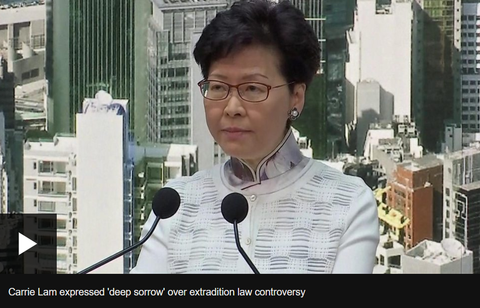
Observers quickly noted this wasn’t the same as a permanent withdrawal, and most assumed Lam was trading space for time hoping to reintroduce the bill next session.
By now the protests had expanded from a single issue: permanent withdrawal of the foreign extradition amendment, to a list of five core demands:
- Permanent withdrawal of the extradition amendment.
- Investigation into allegations of police brutality and misconduct during protests.
- Release of arrested protesters.
- Complete retraction of official characterization of protests as ‘riots.’
- Chief Executive Lam’s resignation.[1]
Four of the five demands emerged from that unseen dynamic of accumulating grievance on events that occurred after the first demand for removal of the bill. From a rational basis of making the ‘smart move’ in refusing an incremental transfer of power from the Dictator to the People, the Dictator was now facing a much larger list of demands. The calculus for granting a compromise hadn’t changed, but the stakes had increased. Lam, and by extension China, had become stuck on the horns of the dilemma. And the struggle of the Hong Kong protests would shift from the legislatures into the streets of Hong Kong itself.
The Battle for Hong Kong’s Streets: July through October 2019
The next evolution of the Dictator’s Dilemma occurs when conflict shifts from control of the governing institutions, where protests in the streets are used to influence legislation, to a battle for the streets themselves.
And this is what occurred over the summer and early fall of 2019 corresponding with the time most Americans became aware of the protests. The evolution follows another system archetype structure depicted in Figure 4.
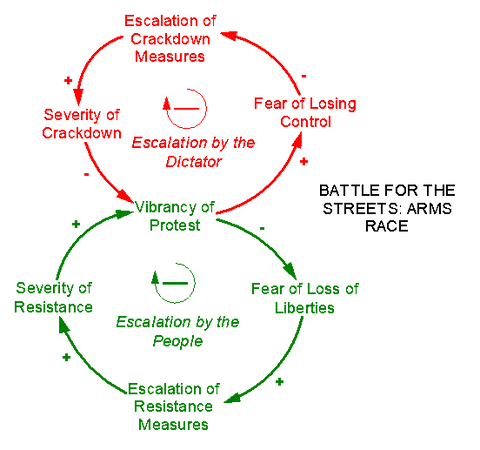
This archetype, known as the ‘arms race’ occurs where each escalation by one party is met by a matching or adaptive escalation by the other party. Again, both are reacting rationally, the Dictator’s fear of losing control provokes and escalation of crackdown measures. And responding to those the People, fearing a loss of liberties, escalate or adapt their own resistance measures. The emergence of this structure, with it’s trading escalations, is also a key signal that the Dictator’s Dilemma has shifted from being fought over influence of the governing institutions and has become a conflict for control of the street.
These escalations may not always be in scale to the provoking action. Responding to incremental escalations of isolated police brutality and misconduct, protesters seriously upped their game on July 1st by storming the legislature and occupying it on the anniversary of the 1997 handover of Hong Kong to China by the United Kingdom [7], [8].
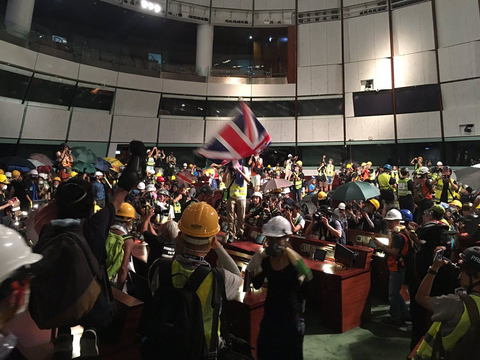
Over the month of July after this action a shifting occurred from civil resistance to non-violent civil disobedience as the protests broadened in support. The protesters now included a broad swath of the adult population of Hong Kong, including civil workers who had been given explicit orders not to protest. Police responded by becoming more confrontational. Protesters responded with more aggressive actions to police. Criminal non-state actors such as Triad criminal gangs were employed to disrupt and harass protesters away from protest sites such as at subway stations [9], [10], [11].
This incremental escalation allows leaderless resistance movements to ‘train up’ and gain experience as a non-state actor. Not just in tactics of countering riot police or defeating surveillance measures. But also, in organizational capabilities of materiel supply networks, command and control capabilities, and communications. These mechanisms are often hidden to the lay observer within the seeming chaos of the protests. But pulling from the existing toolbox of the Umbrella Movement and innovating in response to police escalations the protesters were growing increasingly capable of matching the tactics of the state [12], [13].
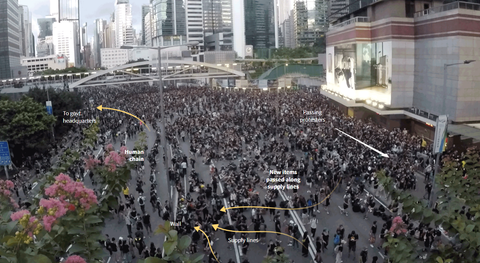
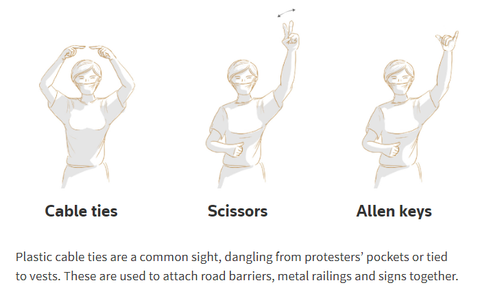
An inflection point arrived however in the occupation of Hong Kong International Airport on August 13th which struck a deep nerve in a city which is isolated accept by sea or air travel. After a mini-riot occurred inside the air-port protesters took a pause to reconsider their tactics [14], [15].
The occupation of the airport by protesters on August 13th represented a key pivot point in the evolution of the Hong Kong protests during the battle for the streets. During the occupation protesters detained and assaulted two men accused of infiltrating the occupation.
The protesters apologized for the violence at the airport and reconsidered their strategy. The camp-occupation tactic used at the airport was pulled from the Umbrella Movement playbook. And although these occupations provided powerful visuals, they also presented ready-made hard targets for police to infiltrate or attack. And it was fears of a repeat of the Umbrella Movement camp attacks that had led protesters to beat the two men they feared were infiltrating their occupation. This had blowback on the movement as it blurred the narrative the People were trying to advance that unlawful violence was entirely on the side of the Dictator.
In asymmetric conflict narrative is often more important than traditional considerations of materiel, morale, technology, or tactics. With the Hong Kong municipal government sidelined by paralysis – the battle for the streets of Hong Kong had become a contest of narratives between the Dictator: Chief Executive Lam, the Hong Kong police forces, and mainland China; and the “People” the protesters. Owning and controlling that narrative, and how it was received in the "global eye of the world" was vital to the sustained success of the protests [16], [17].

To regain control of the narrative, and avoid the failures of the Umbrella Movement, protesters adapted. Overcoming some internal objections, they kept the strategy of intentional non-violence but began using a timing rhythm to conduct protests. A single large massive protest would occur, often outside the boundaries of what had been officially approved, followed by a few days of calm. And the protests were timed, when possible, to occur on symbolic days [18], [19].
The timing of this strategic adjustment proved key because in response to the airport occupation both Hong Kong and China began escalating measures in the arms race in return. Arrests were increased. China began using economic leverage on businesses headquartered in Hong Kong, particularly Cathay Pacific, to identify and report protesters. The CEO of Cathay Pacific famously resigned with a note stating he was the only protester he would name. Social media accounts flooded pro-Chinese propaganda [20]. Pressure on foreign governments was signaled by the arrest of a UK Consulate worker on the border with China and use of criminal gangs as paramilitary forces to disrupt and harass protesters a tactic they had used in the past and returned to in retaliation to the airport occupation [21]. Xi even ordered the movement of Chinese military forces to within striking distance of Hong Kong showing a large stick even as he thrashed the protesters with a switch [22].
But shift to varied timing and shift to rhythmically timed protests from continuous occupation made the protesters a hard target to pin down. Hong Kong wasn’t ‘tipping over’ (sliding into a failed state or civil war) at this point. Outside the limited, and at times random, areas of large protests everyday activities and business continued. This change from the 24/7 occupation style caught the authorities off guard.
Sustained rhythm of periodic protesting was both easier to organize (e.g. if it's a weekend we protest, during the week we live our lives and work normally) combined a respect for the normalcy of everyday life that goes on outside the protests themselves which helps maintain popular support. Modern examples of this timing method include the Yellow Vest protests in France, and even the Iranian Revolution. In that revolution Shia traditions of mourning the dead were leveraged as timing-functions for protests, since one is supposed to mourn the dead on the 3rd, 7th and 40th day after death. These key dates were then used to time regular protests at regular intervals whenever protesters were killed by Shah’s regime [23].
The second shift was to abandon the single locus of protest, key to the 24/7 occupation strategy. There was no clear sustained concentration to attack, no ‘sacred space’ that once lost would signal defeat. If modern protest movements were ‘leaderless’ the 2019 Hong Kong protests innovated a method of ‘placeless’ protesting [24].
Frustrated at the inability to contain this rhythmic and placeless protesting cycle Lam permanently withdrew the foreign extradition bill on September 4th. Too little too late. By September a sixth demand had been added: universal suffrage and the ability to directly elect Hong Kong’s leaders. [25]
This turned the Dictator’s Dilemma from a minor annoyance to an existential crisis not only for Lam, but also Xi in China. Agreeing to direct elections and a representative democracy in Hong Kong might open the floodgates for similar calls across mainland China [18].
This is a key lesson of the Dictator’s Dilemma. It’s like a ridiculous game of no-limit Texas Hold ‘Em with cards continually being added to the flop until one side folds or calls the current bet. Lam could’ve folded months earlier and lost a few chips. But the pot was now too large to walk away from. And each card added to the flop makes the calculation of winning probabilities almost impossible to predict. Neither the Dictator nor the People can with confidence believe they have the winning hand. So, they continue shoving chips into the table hoping to force the other side to fold first than risk the call [26]. These chips represent the available energy to the state and people, and with these linkages the Dictator’s Dilemma structure is complete as shown in Figure 9.

The Battle for the Streets is now linked to the structure through Power of the State, at the top in red and Power of the People, in green at the bottom. These “Power” variables represent the bank of “chips” each side can feed into the Battle for the Streets.
This structure also represents the challenge of leaderless resistance, as the People are just as trapped by the Dictator’s Dilemma now as the Dictator is. Blood has been spilled, rights violated, grievances accumulated, and the protesters aren’t just willing to give up the promise of something greater for a weak compromise on paper. Where the Dictator can’t fold, the People can’t call. Being a leaderless resistance there’s no one person, committee, or council strong enough to make the call and simply meet the last bid. Both sides become trapped in an escalating pattern of violence.
And by mid-September Hong Kong was beginning to tear along the seams, ripping along lines defined by the Dictator’s Dilemma. School became the latest focus point as students who had been on vacation boycotted school in favor of protests and in Hong Kong, where both education and deference of youths to adults is culturally prized, these were taken as a serious escalation [27].
Seams were tearing within the protest moment as well. The philosophical split between a strategy of committed non-violence and violent resistance, first appearing in the 2014 Umbrella Movement now came in full view. Throughout September and into October violence began not only appearing at the edges of protests but popping up in the non-protest areas of ‘normalcy’ in the rest of the city. Whenever Beijing supporters gathered or expressed pro-Chinese sentiments, anti-Chinese extremists would quickly gather, and violence would result. In the protests themselves, small pockets of protesters were now regularly seen throwing Molotov cocktails at police. The command and control network built over incremental escalation was now being put to materiel supply and logistics for sustainment of violent confrontations [28]. Timing a large protest on the 70th anniversary of communist China’s founding put a big black eye on the Communist Party in China. Police were now more likely to respond with lethal violence and the first protester was shot during a melee involving protesters and officers. And the video is telling – this wasn’t necessarily an unlawful use of force. Protesters had succeeded in overwhelming a small isolated police group and beating officers and in response an officer drew his sidearm and fired on the protesters. This wasn’t the first-time ammunition has been fired, but the first time a protester was shot. If you want a threshold to understand when a state is turning over it’s when protests can isolate, overwhelm, and defeat contingents of police requiring escalation to lethal force. The use of criminal non-state actors also became systemic – with targeted beatings of protest leaders far away in time and location from actual protests [29].
The Battle for Hong Kong: November 2019 through ??
Trapped in the dilemma, Chief Executive Carrie Lam pushed all her remaining chips by invoking a power from colonial times to declare a state of emergency and thus institute any laws she deemed necessary for public safety. There’s no more legal authority Lam can call upon and at this point she’s borrowing chips from China to sustain the energy levels needed to maintain the power of the State. With her decrees of banning face-masks used by protesters to defeat surveillance was promptly ignored, as were most other emergency decrees [30].
By mid-November more serious injuries and deaths occurred as police continued escalating against protesters. On Friday November 8th a protester died when he fell as the police were dispersing protesters. This led to a call for another general strike. And on Monday morning, November 11th, when the strike began, police shot an unarmed protester at point blank range caught on video. Shared rapidly via social media it resulted in the general strike becoming a ‘day-of-rage’ which at the time of this writing, still hadn’t ended. Chief Executive Lam is calling the protesters the “enemy of the people” and claiming she ‘spare no effort’ to end the protests [31]. The Chief Executive has become the defacto Dictator and the battle for the streets of Hong Kong has become a battle for Hong Kong itself.
![Figure 10: Screenshot from Video of Unarmed Protester Being Shot by Police (Al-Jazeera) [32]](http://cdn.shopify.com/s/files/1/0247/9785/files/Protester_Shot_large.png?v=1573513133)
How will it end?
It’s impossible to tell for sure. But key to that outcome is who has more chips to play into the escalating pot on the table, or who blinks first to call or fold. Based on historical cases there are several typical ways the Dictator’s Dilemma ends.
- Capitulation by the Dictator.
The State cannot allocate the next marginal increase in power and folds, agreeing to most if not all the demands. What follows is a collapse by the regime. Examples of this are the Arab Spring uprisings in Tunisia and Yemen.
- The Dictator crushes the People.
The Dictator keeps pushing chips into escalation seeking to break the People. Protests become more violent, general strikes turn into days of rage, and uprisings, and eventually civil war. This is the current path of Hong Kong. Historical cases include Assad during the Arab Spring in Syria which resulted in the Syrian Civil war. Caught in the Dictator’s Dilemma Assad fell into a Civil War he couldn’t win on his own until external actors (Russia & Iran) agreed to lend him more chips to play. The Chinese military intervention into Tiananmen Square is another case of this. This seems less likely given Hong Kong’s strategic importance to China as a gateway-economic-zone to the rest of the world and its concern over national image abroad. Still it’s not out of the question if the escalation cycle reaches to significant a point.
- The People crush the Dictator.
When the People have more power or will than the State, they can invest more chips meeting escalation for escalation. If they gain enough popular support, it begins to break apart traditional levers of state power such as the police force. When these groups side with the People over the Dictator, collapse soon follows. Examples of this is the Euromaidan Revolution in Ukraine in 2014. This seems unlikely because lurking just outside the city is the military detachment sent by Xi. Even if the police break to side with the protesters, it’s unlikely the People’s Liberation Army, who aren’t natives of Hong Kong, are unlikely to break.
- Red-Queen Race between Dictator and People
The Red-Queen race is a special case of the arms race archetype, taken from the Alice in Wonderland story. In the Red-Queen race each runner must run faster just to stay in the same place. Likewise, if both State and People can continually meet each other’s escalations by throwing in more chips a crippling stalemate emerges. It’s not civil war, as in Syria, but it’s a close second as the economy collapses, riots and extra-judicial violence become the norm, and governance falls apart. Venezuela is an example of the Red-Queen Race emerging from the Dictator’s Dilemma.
- Deep-State Rope-a-Dope
The final alternative is the one we see as most likely Hong Kong, at least in the intermediate term. The Rope-a-Dope occurs when a Deep-State can ‘eject’ a leader, representative of the Dictator’s side. This creates a short-term perception of progress and protesters can quickly turn against one another to shape the new-order of society. This is like taking your eye of the goal line in the final 5 yards of a touchdown run. Then the Deep-State comes rocketing in like a free safety driving the protesters into the ground just short of the goal-line. With protesters factionalized by their efforts to reorder society the Deep-State can divide and conquer. This was the outcome of Egypt in the Arab Spring where Mubarak’s fall was just prelude to the return of the Deep State. Given China’s role, and interests in Hong Kong, we view this as the most likely resolution.
Trivial Epilogue
And what of Chan? The man suspected of murdering his girlfriend in Taiwan that precipitated the Dictator’s Dilemma? After spending two years in Hong Kong jail he agreed to voluntary extradition to Taiwan, realizing it was better to get out of Dodge. A deadbeat absentee father who unintentionally birthed the conditions of a Dictator’s Dilemma that seems increasingly likely to be remembered by history as the Hong Kong Revolution or a Tiananmen style military intervention.
Bibliography
|
[1] |
https://en.wikipedia.org/wiki/2019_Hong_Kong_protests. |
|
[2] |
T. Clancy, Facebook Commentary, June 15th, 2019, https://www.facebook.com/tim.clancy.313/posts/10210483889094091. |
|
[3] |
Clancy, T. Facebook Commentary, September 4th, 2019, https://www.facebook.com/tim.clancy.313/posts/10210898767345788. |
|
[4] |
https://en.wikipedia.org/wiki/Umbrella_Movement. |
|
[5] |
Clancy, T., "Systems Thinking: Three System Archetypes Every Manager Should Know", (If copy is unaccessible contact author for copy. timc@dialecticsims.com): https://ieeexplore.ieee.org/document/8404057. |
|
[6] |
BBC, https://www.bbc.com/news/world-asia-china-48645342. |
|
[7] |
The Gaurdian, https://www.theguardian.com/world/live/2019/jul/01/hong-kong-braces-for-huge-protests-on-anniversary-of-china-handover-live. |
|
[8] |
Clancy, T. Facebook Commentary, AUG 4, 2019, https://www.facebook.com/tim.clancy.313/posts/10210564861678355. |
|
[9] |
Al-Jazeera, August 4th, 2019, https://www.aljazeera.com/indepth/features/playing-time-china-hong-kong-deepening-protests-190730190245184.html. |
|
[10] |
Al-Jazeera, August 8th,, https://www.aljazeera.com/news/2019/08/protesters-aim-paralyse-hong-kong-city-wide-strike-190804230325813.html. |
|
[11] |
Clancy, T., Facebook Commentary, Agust 8th, 2019, https://www.facebook.com/tim.clancy.313/posts/10210743078573666. |
|
[12] |
Reuters, August 12th, https://graphics.reuters.com/HONGKONG-EXTRADITIONS-TACTICS/0100B0790FL/index.html?fbclid=IwAR1K1OIxdvbE6OQgPjMe5Myw2bkGdAezE6pB5vYoXJl82D-t5nqDOPC5qQo. |
|
[13] |
Clancy, T., Facebook Commentary, August 12th, 2019, https://www.facebook.com/tim.clancy.313/posts/10210784490728944. |
|
[14] |
Al-Jazeer, August 13th,, https://www.aljazeera.com/news/2019/08/clashes-erupt-hong-kong-airport-flights-disrupted-190813152753910.html. |
|
[15] |
Clancy, T., Facebook Commentary, August 13th, 2019, https://www.facebook.com/tim.clancy.313/posts/10210790950770441. |
|
[16] |
Al-Jazeera, August 14th,, https://www.aljazeera.com/news/asia-pacific/2019/08/hong-kong-protesters-apologise-airport-chaos-190814151751512.html. |
|
[17] |
Clancy, T., Facebook Commentary, August 14th, 2019, https://www.facebook.com/tim.clancy.313/posts/10210795253358003. |
|
[18] |
Al-Jazeera, August 19th,, https://www.aljazeera.com/news/2019/08/tens-thousands-march-latest-hong-kong-protest-190818072454790.html. |
|
[19] |
Clancy, T., Facebook Commentary, August 19th, 2019, https://www.facebook.com/tim.clancy.313/posts/10210817981806200. |
|
[20] |
NY Times August 21,, https://www.nytimes.com/2019/08/19/technology/hong-kong-protests-china-disinformation-facebook-twitter.html. |
|
[21] |
NY Times, July 24th, https://www.nytimes.com/2019/07/24/world/asia/hong-kong-triads-protests.html. |
|
[22] |
New York Times, August 19th,, https://www.nytimes.com/2019/08/18/business/economy/hong-kong-china-business-workers.html?action=click&module=Top%20Stories&pgtype=Homepage. |
|
[23] |
Brookings, Timing in Iranian Revolution, https://www.brookings.edu/blog/order-from-chaos/2019/01/24/the-iranian-revolution-a-timeline-of-events/. |
|
[24] |
NY Times, August 28th, https://www.nytimes.com/2019/08/27/world/asia/is-hong-kong-safe.html. |
|
[25] |
Al-Jazeera September 4th,, https://www.aljazeera.com/news/2019/09/hong-kong-lam-declare-scrapping-extradition-bill-reports-190904064616306.html. |
|
[26] |
Clancy, T., Facebook Commentary, September 4th, 2019, https://www.facebook.com/tim.clancy.313/posts/10210898767345788. |
|
[27] |
Al-Jazeera, September 16th, https://www.aljazeera.com/news/2019/09/hong-kong-100-days-huge-rallies-violent-clashes-190916035319152.html. |
|
[28] |
Clancy, T., Facebook Commentary, September 16th, 2019, https://www.facebook.com/tim.clancy.313/posts/10210963175875961. |
|
[29] |
Al-Jazeera, October 6th,, https://www.aljazeera.com/news/2019/10/hong-kong-thousands-protest-bid-block-face-mask-ban-fails-191006051700382.html. |
|
[30] |
Clancy, T., Facebook Commentary October 6th, 2019, https://www.facebook.com/tim.clancy.313/posts/10211068265543137. |
|
[31] |
Al-Jazeera, November 11th, https://www.aljazeera.com/news/2019/11/hong-kong-crisis-escalates-protester-shot-police-191111104452680.html. |
|
[32] |
Al-Jazeera, November 11th, https://www.aljazeera.com/news/2019/11/hong-kong-protester-shot-street-confrontation-police-191111013907715.html. |
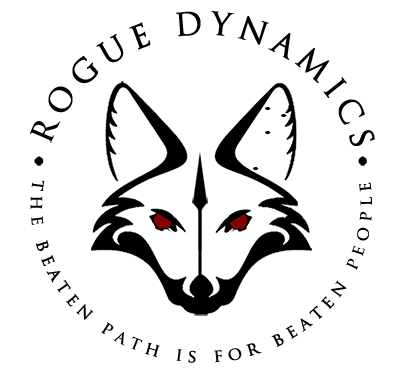


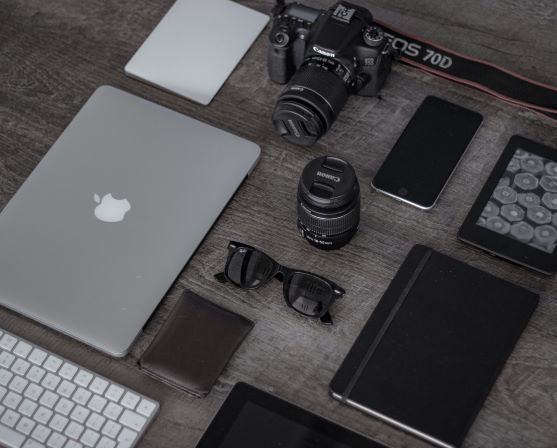
Marcus Henderson
July 19, 2025
Bitcoin Recovery Testimonial
After falling victim to a cryptocurrency scam group, I lost $354,000 worth of USDT. I thought all hope was lost from the experience of losing my hard-earned money to scammers. I was devastated and believed there was no way to recover my funds. Fortunately, I started searching for help to recover my stolen funds and I came across a lot of testimonials online about Capital Crypto Recovery, an agent who helps in recovery of lost bitcoin funds, I contacted Capital Crypto Recover Service, and with their expertise, they successfully traced and recovered my stolen assets.
Their team was professional, kept me updated throughout the process, and demonstrated a deep understanding of blockchain transactions and recovery protocols. They are trusted and very reliable with a 100% successful rate record Recovery bitcoin, I’m grateful for their help and highly recommend their services to anyone seeking assistance with lost crypto.
Contact: Capitalcryptorecover@zohomail.com
Phone CALL/Text Number: +1 (336) 390-6684
Email: Recovercapital@cyberservices.com
Website: https://recovercapital.wixsite.com/capital-crypto-rec-1